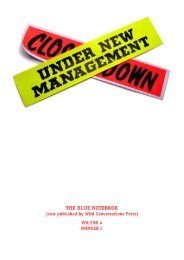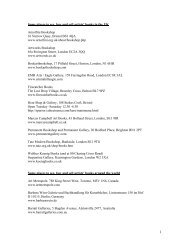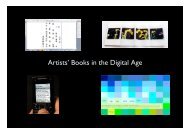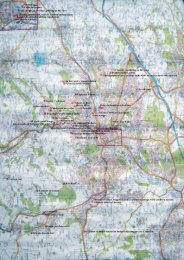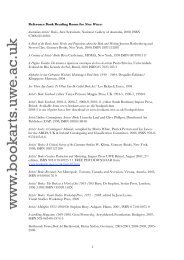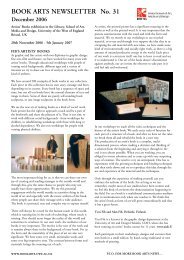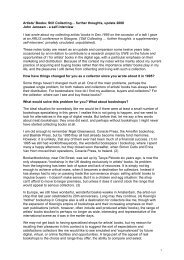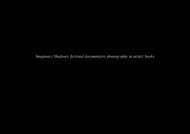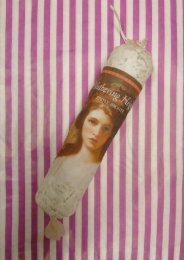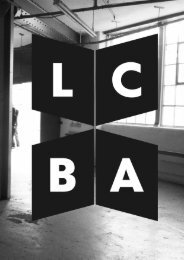Artist's Book Yearbook 2003-2005 - Book Arts - University of the ...
Artist's Book Yearbook 2003-2005 - Book Arts - University of the ...
Artist's Book Yearbook 2003-2005 - Book Arts - University of the ...
You also want an ePaper? Increase the reach of your titles
YUMPU automatically turns print PDFs into web optimized ePapers that Google loves.
Smith was exploring ways <strong>of</strong> bringing his work<br />
to a wider audience and though he had shown<br />
extensively within a museum context in <strong>the</strong> UK<br />
and abroad, had not yet found a satisfactory<br />
way <strong>of</strong> translating this most private aspect <strong>of</strong> his<br />
practice into work which could be shown or<br />
disseminated.<br />
The work was intriguing and beautiful but how<br />
it fitted within <strong>the</strong> framework <strong>of</strong> a commercial<br />
gallery took a long time to resolve since its<br />
resonance depended upon <strong>the</strong> specificity <strong>of</strong> its<br />
location. A bookwork seemed a logical way <strong>of</strong><br />
containing <strong>the</strong> documentary aspect, but Smith<br />
was anxious that <strong>the</strong> approach taken to making<br />
<strong>the</strong> publication follow as closely as possible his<br />
wider working methods. Thus <strong>the</strong> book Site<br />
Unseen was conceived as a ‘page specific’ site<br />
that would reveal a single project through a<br />
narrative <strong>of</strong> visual images, working notes and<br />
commentaries and a longer poetic text.<br />
Funding from <strong>the</strong> <strong>Arts</strong> Council made <strong>the</strong><br />
project possible, but it also imposed parameters<br />
that led to a different way <strong>of</strong> making <strong>the</strong> book<br />
than in previous publications. We were<br />
required to print in a run <strong>of</strong> 500 or above and<br />
to explore ways <strong>of</strong> distributing <strong>the</strong> book wider<br />
than <strong>the</strong> network <strong>of</strong> individuals, collections and<br />
libraries that had previously bought <strong>the</strong> smaller<br />
edition publications. Budget dictated that <strong>the</strong><br />
book would largely have to be printed using<br />
commercial lithography and <strong>the</strong> most efficient<br />
tool to bring all <strong>the</strong> different elements toge<strong>the</strong>r<br />
was <strong>the</strong> computer. Within <strong>the</strong> financial<br />
restraints however <strong>the</strong>re was a determination to<br />
use material and design to mirror <strong>the</strong> working<br />
process <strong>of</strong> <strong>the</strong> artist who had made a series <strong>of</strong><br />
sculptural drawings into <strong>the</strong> fabric <strong>of</strong> a derelict<br />
house, exposing layers <strong>of</strong> its history down to<br />
<strong>the</strong> la<strong>the</strong> and plaster skeleton. Images were<br />
chosen as much for <strong>the</strong>ir potential to convey<br />
<strong>the</strong> atmosphere <strong>of</strong> <strong>the</strong> house as <strong>the</strong>y were to<br />
show <strong>the</strong> artist's interventions upon it while<br />
pages <strong>of</strong> different materials were layered<br />
toge<strong>the</strong>r or cut through with perforations and<br />
apertures to parallel <strong>the</strong> sense <strong>of</strong> revealed form<br />
and pattern.<br />
We were fortunate in <strong>the</strong> two writers involved in<br />
Site Unseen. James Putnam, who put <strong>the</strong> project<br />
into <strong>the</strong> wider context <strong>of</strong> Smith’s practice and<br />
highlighted <strong>the</strong> crucial interplay between <strong>the</strong><br />
96<br />
“actual and <strong>the</strong> metaphorical” that runs<br />
through all <strong>the</strong> work and Mel Gooding who<br />
understood implicitly how his text must<br />
function to complement and reveal in language<br />
<strong>the</strong> sensation <strong>of</strong> <strong>the</strong> hidden site, which he did<br />
most eloquently.<br />
Site Unseen was published in <strong>the</strong> context <strong>of</strong> an<br />
installation at <strong>the</strong> Eagle Gallery and was <strong>the</strong><br />
inspiration behind a number <strong>of</strong> <strong>the</strong> books that<br />
followed which were approached on a much<br />
more complex level and developed as an<br />
extension <strong>of</strong> <strong>the</strong> work we were showing in<br />
exhibition. It was important as a publisher to<br />
ask what kind <strong>of</strong> an audience <strong>the</strong>se works were<br />
for, since <strong>the</strong> arena for artists’ books in <strong>the</strong> UK<br />
is a small one and <strong>the</strong> Gallery could only<br />
operate in a limited way as a distributor. It<br />
seemed to make more sense to stay at <strong>the</strong> ‘fine<br />
art’ end <strong>of</strong> making artists’ books than to<br />
attempt to produce longer runs where quality<br />
<strong>of</strong> purpose and print would be limited by<br />
budget and where to make any kind <strong>of</strong><br />
financial returns large numbers <strong>of</strong> <strong>the</strong> books<br />
would have to be sold.<br />
Two fundamental questions interested me and<br />
were born out <strong>of</strong> <strong>the</strong> experience <strong>of</strong> making<br />
previous books and in thinking about <strong>the</strong><br />
context in which we were showing <strong>the</strong>m. The<br />
first was whe<strong>the</strong>r we could make publications as<br />
objects that would appeal to people even before<br />
<strong>the</strong>y had read <strong>the</strong> text or properly looked at<br />
<strong>the</strong> images. Our immediate audience was <strong>the</strong><br />
mixture <strong>of</strong> private individuals, consultants and<br />
curators that passed through <strong>the</strong> gallery and<br />
though <strong>the</strong>re was interest in <strong>the</strong> books <strong>the</strong>re<br />
was a hesitancy about <strong>the</strong>m as collectible works<br />
<strong>of</strong> art. The second and far more difficult issue<br />
was how one could commission genuine<br />
collaborations between an artist and writer<br />
within a framework which would allow <strong>the</strong>m<br />
<strong>the</strong> time and flexibility to develop a work which<br />
properly integrated <strong>the</strong> various languages<br />
involved.<br />
In 1999 I set up a subscription scheme to<br />
publish five artists’ books that could be<br />
developed over a period <strong>of</strong> years ra<strong>the</strong>r than<br />
months. The scheme was designed to raise a<br />
starting fund <strong>of</strong> £20,000 which would be<br />
supplemented by grant funding, sponsorship<br />
and sales <strong>of</strong> <strong>the</strong> published books.




